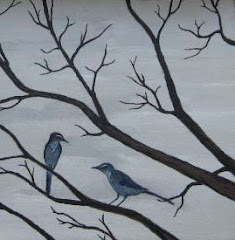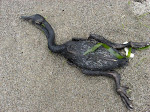I started a
blog about a month ago for my wife and I to share photos of our dog and birdwatching expeditions. Today I realized that I have been hogging it for my own shameless self-promotion, so I will start a new blog of my own with something I posted on the other blog today.
New Love For Doves
Posted at 10:49 AM, Tuesday, February 12, 2008
During the last two days, I have been working on mourning dove nesting data while viewing the same species on my deck. We finally refilled our feeders, so the birds have returned.

This pair spent the morning eating, stretching, preening, and, lets say, "bonding" on the deck.

Another well-illustrated nest sheet.
I must admit that, until recently, I had little respect for doves. Their small heads and bobbing gait made them look less intelligent than other birds. Species like mourning doves are often so abundant, that while birding, I often dismissed an individual on a wire as “just another mourning dove.” Mourning doves, or (MODOs for short) have never won marks in my book for nest craftsmanship either. Of all the nests I’ve viewed, MODO nests appear the most sloppily built and precariously positioned. They choose all sorts of inappropriate substrates such as large pieces of bark that dangle from a dead tree, waiting for to be dislodged by the next stiff breeze. Somehow, enough of their nests survive to keep the population afloat. Most nest fail, however, making me wonder how the species survives.
Since they started frequenting our small bird feeding deck, however, we have come to enjoy their company and laugh at their lack of modesty when, starting in winter and lasting through the fall, they perform their matrimonial rites in front of our sliding glass doors. We are also impressed with their surprisingly assertive nature. When the usually bold scrub jays show to hog the seed, MODOs often fluff out their feathers and hold their ground or charge the jay. They don’t win every confrontation, but they do retain their deck rights at least half the time.

This dove simply waited for the aggressive red-winged blackbird to get his fill of seed before reclaiming the dish for itself.

Now that I am analyzing a stack of MODO nest records for the Forest Service, I have a new found interest in this bird’s fascinating breeding biology. No other species that I have studied can nest as many times in a single breeding season. MODOs can complete a successful nesting attempt much faster that most birds their size. MODOs do not need to migrate as far as some birds to nest and they spend very little time building a nest. Both species incubate, never leaving the nest unattended. This allows no time for the eggs to cool and slow development. When the eggs hatch, they are fed cropmilk from both parents, a constantly available food source that takes no time to gather and bring to the young. When the nestling fledge, the male continues to make cropmilk and feed the fledglings while the female starts on her next nest. In some places this cycle occurs throughout the year, in others it extends from February to October, at my study sites in New Mexico, it occurs from March to late August.
The impressive nest-building rate of mourning doves helps the population persist despite high mortality rates of nests, fledglings, and adults. My current project with the forest service examines the effects of fuel reduction treatments on MODO nest survival. I expect to find low daily survival rates at all plots, but if survival rates in fuel-reduced plots are similar to those of unmanaged plots, the MODOs populations should have no trouble surviving in the midst of this management practice.

























 This pair spent the morning eating, stretching, preening, and, lets say, "bonding" on the deck.
This pair spent the morning eating, stretching, preening, and, lets say, "bonding" on the deck. Another well-illustrated nest sheet.
Another well-illustrated nest sheet. This dove simply waited for the aggressive red-winged blackbird to get his fill of seed before reclaiming the dish for itself.
This dove simply waited for the aggressive red-winged blackbird to get his fill of seed before reclaiming the dish for itself.





